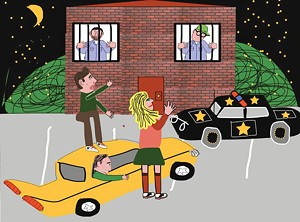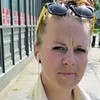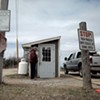Published June 20, 2012 at 10:10 a.m. | Updated November 13, 2020 at 4:52 p.m.
In his Burlington studio, dug Nap folds himself, origami-like, into a chrome-and-black-leather chair. Preparing to run through his upcoming performance-art piece, “Napshots of the Suburbs,” he casually fires up a digital projector and begins to click through the slides.
“This is Stevie’s grandmother’s house,” Nap says as one image flashes into view. “This is just down the street from where I grew up.”
The presentation feels like a slide show for friends in which Nap narrates old photographs from his childhood. But in place of photographs, the images he projects on the screen are childish scrawls, illustrations that Nap conjured on his iPad over the course of more than a year. And it’s no family slide show; this is an outtake from a new series of autobiographical monologues that launches at the FlynnSpace this week, on June 21 and 22.
Part spoken word, part picture book, “Napshots of the Suburbs” may come as a surprise to those who know Nap only by way of his quirky artwork and greeting cards. Or from his weekly appearances at, say, the Artist Market in City Hall Park. Arguably Burlington’s most recognizable artist, Nap is toweringly tall and thin, with close-cropped gray hair and large, black-rimmed glasses. Voted Vermont’s favorite visual artist in 2008 and 2009 by Seven Days readers, he’s best known for his irreverent prints and paintings in which colorful images butt up against a childlike scrawl. His slogans run the gamut from sardonic (“Eat, drink & be overweight & alcoholic”) to whimsical (“Life is shor”) to droll (“If a man speaks in a forest & no woman hears him — is he still wrong?”). All reflect Nap’s observations of the foibles of humankind.
“Napshots,” by contrast, is a deeply personal, introspective work — laced with Nap’s witticisms but also hinting at trauma, confusion and the loneliness of a difficult childhood. He envisions this as the first in a broader series, called “Napshots of my Life,” in which the title character — also named “dug Nap” — returns to the fictional town of Starksbend and to the scenes of his childhood and adolescence. Real-world Nap makes a clever disclaimer in the monologue’s program: “Many will deny that any of this ever happened, but even though ‘Napshots’ contains a lot of fibs, half-truths and lies — I swear it’s all true.”
The show is confessional, but the offstage Nap manages to be both strangely unguarded — the result of more than two decades of therapy, he says — and maddeningly evasive. Ask him his age, and the sixtysomething demurs, “I’d rather not say.” He’s cagey talking about his boyhood. He grew up in Montpelier, he admits, but he’s secretive about the details; Nap wants to save the juicy bits for the stage.
In another artist’s hands, “Napshots” might be cloying or overly self-indulgent, but, even five decades removed from his childhood, Nap is endearingly earnest about the undertaking. He sounds convincingly childlike as he clicks through the slides in the performance’s third act (in which, according to the program, “dug hangs out with the other kids in the new neighborhood, insects are killed, and they show each other their things”). “Wow, I would like to live in a world with roast beef sandwiches,” he murmurs longingly, after remembering the delicious lunches his friend Bobby’s mother packed for the boy. He marvels at the nudist magazines at another friend’s house. “Every magazine in our house had clothes,” Nap says. And, when Stevie’s older sister, a teenage vision, stepped into the living room in her bathrobe, Nap recalls with some confusion the “bird’s nest” he spotted when her robe accidentally shifted open.
Tonight, in his studio, he’s reliving these scenes before a motley crew of friends, friends of friends and one reporter. The 10-member audience is seated on an odd assortment of chairs in a dim, dusty space, among dirty wooden floors and exposed pipes. It’s a Friday evening, the week before Nap’s show opens at the FlynnSpace, and into the rehearsal space drifts the noise of the city on a summer night: voices from the sidewalk, the sound of a car accelerating, someone calling out to a friend.
Nap sits to one side of the screen, empty-handed except for the device that controls the images. In a black button-down shirt, jean shorts and sandals over black socks, he seems to disappear in the makeshift theater: The images, more than 300 of them, take center stage.
Nap illustrated his show using a stylus on his iPad; the earlier efforts are, in his estimation, “primitive,” but as he mastered the application, the drawings became more and more nuanced. Some details are drawn freehand. Others, like a poster on a bedroom wall or the image on a television screen, are clipped from digital photographs and pasted, collage-like, into the scene. The snapshots are a mashup of straight lines, computer-generated geometric shapes and Nap’s customary sloppiness. Nap uses them in a kind of geographic storytelling: He leads his audience from house to house, from room to room, from one end of the neighborhood to the other, and the stories tumble out along the way.
There’s the story of an expedition to Rabbit Rock with some of the boys from the Starksbend ’hood. These images are deeply saturated and brilliantly colored. “Dug” appears, as he almost always does, in pea green. When the story crescendos in an odd sexual encounter — the other boys dare “dug” to put his mouth on their penises — the small audience falls silent. In Nap’s version of the story, the boys hash out a deal in which they’ll all reciprocate the act, but in the end the others renege. Nap’s voice is soft and gentle; as he recalls the scene, he sounds not unlike a 9-year-old boy still trying to work out the confusing dynamics of the encounter.
Even so, the dug Nap brand of humor breaks through. “They broke their promise,” he says of the other boys, adding after a beat, “I heard that they did become lawyers.”
If “Napshots” — with its mix of autobiography, visual art and spoken word — is hard to classify, that problem has dogged Nap’s work from the outset: Tidy labels never seem to fit.
That’s what Pat Parsons, who owned a gallery in Burlington in the late 1980s, discovered when she took Nap’s work down to New York City. Her gallery has since closed, though Parsons still dabbles in art dealing and splits her time between Burlington and Essex, N.Y. She specialized in contemporary American art, with a focus on self-taught artists, and Nap fit the bill. Or seemed to.
“[Self-taught artists] usually have a very unique and individual perspective, and that’s what I saw in dug almost immediately,” Parsons says.
But that uniqueness didn’t make her job as an art dealer any easier. Nap’s work is often classified somewhere between “folk” and “outsider” art — the latter term is used to describe art created outside the boundaries of official culture and often by patients at mental institutions. Parsons, who believes Nap’s work is more sophisticated than most outsider art, says she was taken by his mixture of words, images, lines and colors. Collectors, however, like neat classifications, she says.
“For most people, he’s a hard sell,” Parsons says. “He doesn’t fit any of these categories, and that’s one of his problems. He blurs all the boundaries. People either love him or don’t get him.”
Nap approached Parsons on the advice of a friend — “just for the hell of it,” he recalls — not long after he took up painting seriously. That was in the late ’80s, when he was creating large-format oil paintings. He was too broke to afford both oil paints and canvases, so he salvaged sheets of plywood from dumpsters around Burlington and painted directly on the boards. He fashioned his own frames, too, from pieces of strapping. He learned his painting technique from a few how-to books and some advice from artists. (Nap has since amassed an impressive collection of art books and pulls inspiration from Grandma Moses, Vermonter Gayleen Aiken and Morris Hirschfield, among others.)
Nap’s first show in Burlington was in Parsons’ gallery, and she still owns several of his early works “that haven’t been transformed into a million copies,” she says. One Nap show Parsons curated consisted of autobiographical paintings of his family — a precursor to the subjects Nap is now exploring in “Napshots.”
“We’re all dealt different hands,” the artist says, explaining why he feels compelled to go back to this material. “We’re all entitled to our stories.”
Sharing one of the few details he will divulge about his childhood, Nap says he was good at art and not much else. In other interviews — some more than 15 years old — he alluded to drinking and doing drugs heavily as a teenager. After being kicked out of school, Nap was shipped off to a military academy in New Jersey for a year. Then, at 17, he ran away from home. He lived on the streets of Greenwich Village for one summer, sleeping on rooftops and hanging out in clubs. He was experiencing the symptoms of what would later be identified as schizophrenia, a diagnosis that landed Nap in the Vermont State Hospital for two years.
“Not the schizoid where it’s like, ‘the 31 dugs’!” Nap says. But, he says, he was cut off from reality. “It’s kind of like, I had a different engine in me then.”
Nap is grateful for that time in the hospital. “After living a wild life before that, I turned myself around,” he says. A young doctor from Germany (“who’d even done LSD himself,” Nap remembers) took an innovative approach to Nap’s treatment, taking him off his meds and putting him in one of the back wards. On Wednesdays, the patients and attendants at the institution gathered for art therapy.
“I got into art there; I got into songwriting there,” Nap says. “In a lot of ways, that was like a place where I was reborn.”
After leaving Waterbury, Nap ping-ponged between short-term jobs — nothing he really cared about, he says, but positions he took because he’d been taught to think of art as a hobby rather than a vocation. He returned to school and graduated from Johnson State College with a degree in English in 1978. At JSC, he met musicians with whom he would form the band Pinhead. The group moved to Burlington in the early ’80s and performed frequently at a lower Main Street club called Hunt’s Mill & Mining Company, as well as at Nectar’s and other venues. A little bit punk, a little bit New Wave and all original, Pinhead were immediately popular. Nap wrote all the lyrics — and sang, too, “if you want to call it that at the time,” he says.
Nap still plays music, though his tastes run more to Leonard Cohen than the Clash these days. He says he writes a lot of “lonely” songs, and he’s bashful about performing — at least for small crowds. Playing and singing music make Nap more nervous than do his spoken-word performances, which include a twice-monthly stint hosting the Poe Jam at the BCA Center.
Today, Nap talks about his favorite forms of art — visual art, spoken word and music — as if they’re children. He typically spends a little time with each, juggling different projects, playing favorites when one project is especially compelling.
But Nap’s visual art, and especially his print business, is by far his most time-consuming pursuit. It’s also his moneymaker. For all his quirks, Nap is a shrewd businessman: He is a consistent top seller among more than 200 artists represented at the Frog Hollow Vermont State Craft Center on Church Street.
He wasn’t always so successful. When now-executive director Rob Hunter joined Frog Hollow as its Middlebury gallery director in 2005, that outpost featured only two Nap paintings. “They were framed, they were on a post, and they were facing a wall,” Hunter recalls. That is to say, no one took much notice.
In fact, Nap’s work was never a huge splash in Middlebury (Frog Hollow’s gallery there has since closed). Hunter thinks his work is better suited to Burlington’s city-folk clientele. Nap found his niche, according to Hunter, when he began churning out 8.5-by-11-inch prints at a comfortable price point — $16.95 a pop in Frog Hollow’s Burlington shop. They’re now the mainstay of Nap’s business, following on the heels of his initial commercial success in the greeting-card world. For a long time, Nap drew and colored each card by hand; then he hired help to keep up with the coloring, before finally moving to digitally printed cards.
Nap is as much an entrepreneur as he is an artist. Even his unconventional take on spelling his name — he was born Douglas Knapp — was influenced, in part, by his business savvy. He liked the truncated version because it seemed to come from the same “kid’s place” that inspired his art, but the short moniker also appealed to “the marketing side of me,” Nap says. He liked how it looked on a poster and figured it might be more memorable than his given name. “Fewer letters can be seen further,” he reasons.
Hunter says he tries to drive home to all of Frog Hollow’s artists and crafters that an artist’s presence in the gallery affects sales. “Dug is the master at it,” Hunter says. In May, Nap set up his “art bed” in the window of Frog Hollow for a monthlong residency, and Hunter jokes that his staff was frustrated because Nap, gregarious and personable, would beat the sales team to greeting shoppers. During the holiday rush, Nap is in the gallery almost every day, sauntering the shop floor with an oversize pen — bigger than a baseball bat — slung over his shoulder for signing prints. Nap isn’t just selling a print, Hunter says — he’s selling the story that goes with it.
“People just go crazy about the idea of that accessibility to a creative spirit,” he says.
And there’s a lot of Nap’s work for fans to collect: “He’s very prolific,” says Parsons. The question is, she asks, “How do you translate that into a livelihood?”
Reticent as he is when discussing his childhood, Nap isn’t shy when it comes to talking business. Unlike some artists who might fear selling out, Nap, even early on, was clear eyed about the necessity of balancing art and money.
“I knew that I had to sell stuff, because I liked doing it,” says Nap. So he gave up any illusions of hanging on to his art for sentimental reasons; he’d take a snapshot of a painting and happily send it on its way. Practical concerns also motivated his transition from large oil paintings — which he still produces, just not exclusively — to prints and cards. He quickly realized he couldn’t support himself on shows that might yield a single sale each. So Nap turned to greeting cards, partly because his job at the time as a parking-garage attendant allowed him to draw while he worked.
“I never felt like I was selling out,” Nap says. “I’ve always done stuff that I liked.”
For all his salesmanship and friendliness, Nap considers himself a lonely person. He took up his iPad as a means of illustration in part because the device was so portable; suddenly he could work in coffee shops and bars, adjacent to the goings-on of life in Burlington. Yet, even there, Nap often remains a solitary figure. After a freewheeling youth, he doesn’t smoke or drink or do drugs, and he frequently disparages that lifestyle.
“I can be really critical, I guess, of booze and bars and creating this imaginary fantasy world and selling people tickets to their destruction,” he says wearily. In this life, Nap says, “You’re given so many tickets to spend, and I’ve spent mine.” So he watches from the sidelines as others dole out theirs, and he draws.
“When I was growing up, I was dysfunctional. Maybe everyone else around me was normal,” he says. “But what can happen later is, you become normal, and everyone else [becomes strange].” It’s a Catch-22, though — because Nap acknowledges that in rejecting so many social norms, he’s still stuck being “abnormal.”
He has never married, and, aside from one girlfriend — as well as one “imaginary girlfriend,” the subject of a 2007 performance piece — he’s never settled into a serious relationship.
In lieu of a family, Nap has thrown himself wholeheartedly into his work. What started as art therapy at the Vermont State Hospital continues as a form of self-reflection for Nap. “People that stuff things, they end up stuffing everything,” he says, alluding to repression. “If you stuff your sadness, then that’s hooked to your happiness, your fear, everything else.”
A self-proclaimed workaholic, Nap says he’s the kind of person who will “get an idea for something, and then I’ll just carry through.” (He pronounces idea “idear,” a remnant of his New England upbringing.) The art bed was like that: “OK, I’m not comfortable making art sometimes standing up,” he explains. “Therefore, I’m going to make a bed on wheels. It’s going to go underneath my easel. And sometimes I’m going to paint lying down.”
Nap began writing the monologue for “Napshots” about three years ago. It started as a prose play, with notations where he thought illustrations might come in handy. Once he started drawing, Nap says, he couldn’t stop; he abandoned pen-and-ink drawings and watercolors in favor of the iPad in part to expedite the enormous undertaking. With this show, he says, he’s giving himself permission to explore — and the images “just kept coming and coming and coming.” Referring to the show’s 300 images, he recalls thinking, “No one would stand for that!” Now the four-act play includes even more pictures, some of which Nap is frantically rushing to finish just days before the show.
After his rehearsal, Nap stands up from the chair on his makeshift stage. At 6-foot-4, he looms beside the now-empty screen. Then, with the same intensity and drive he brings to his own introspection, Nap begins grilling his impromptu workshop for reactions. (“It’s like therapy!” he jokes brashly, as he launches into the conversation.) Longtime friend and fellow artist Bobbie Lanahan marvels at the show’s poignancy. “The drawings are charming,” she assures Nap — more charming than she thought computer-drawn illustrations could be, she adds.
Audience members fire off a few questions — about Nap’s humor, about the “fourth wall” in theater — and eventually get up to mingle in the fading light of his studio. Nap’s voice grows quieter and softer when he thanks his friends for coming. He concedes that “Napshots” is an intensely personal show — indeed, it’s an almost voyeuristic look at Nap’s dramas and neuroses.
But he hopes it will speak to a broader audience. Nap jokes that he’ll have to have a therapist on hand at his show “just in case” it dredges up uncomfortable memories in the audience members. Unlike many of us, Nap is willing to confront those feelings head-on.
“What I’m doing in this piece is pretty personal, and it may not be everyone’s cup of tea,” he says. “But it’s also not going on your wall.”
Unless you’d like it to — in which case, as the consummate salesman points out in his program, prints of his iPad images are available by request.
“Napshots of the Suburbs,” written, illustrated and performed by dug Nap. Thursday, June 21, and Friday, June 22, at 8 p.m. at FlynnSpace in Burlington. $14-18. flynntix.org
More By This Author
About the Artist

Matthew Thorsen
Bio:
Matthew Thorsen was a photographer for Seven Days 1995-2018. Read all about his life and work here.
Matthew Thorsen was a photographer for Seven Days 1995-2018. Read all about his life and work here.
Speaking of Art
-

Q&A: Catching Up With the Champlain Valley Quilt Guild
Apr 10, 2024 -

Video: The Champlain Valley Quilt Guild Prepares for Its Biennial Quilt Show
Apr 4, 2024 -

Q&A: Meet a Family in Waterbury That Embraces Halloween Year-Round
Feb 14, 2024 -

Video: Goth Family in Waterbury: Sarah, Jay and Zarek Vogelsang-Card
Feb 8, 2024 -

Q&A: Art Entrepreneurs Tessa and Torrey Valyou Celebrate 15 Years of New Duds
Oct 11, 2023 - More »
Comments
Comments are closed.
From 2014-2020, Seven Days allowed readers to comment on all stories posted on our website. While we've appreciated the suggestions and insights, right now Seven Days is prioritizing our core mission — producing high-quality, responsible local journalism — over moderating online debates between readers.
To criticize, correct or praise our reporting, please send us a letter to the editor or send us a tip. We’ll check it out and report the results.
Online comments may return when we have better tech tools for managing them. Thanks for reading.














































